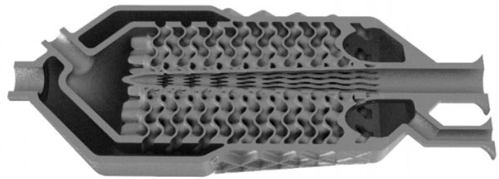Page 17 – Heat Exchange
The Stirling engine is really
just a set of heat exchangers.
The heat of the burner
is transferred into the metal of the hot cap.
The hot metal
then transfers the heat into the gas inside the engine.
The
regenerator transfers heat from hot gas into its thin wires and
then back into the gas.
For each stroke of the engine.
Then
the cooler takes remaining heat from the gas and transfers it to
the cooling water jacket.
Robert Stirling’s
patent details four types of heat exchanger. The engine is just
one example.
Inside the engine, heat only transfers
from metal to gas, or vice versa, when molecules
touch the
metal. Thus the need to maximise the surface area of the metal
with as many
tightly packed fins as possible.
If
the air is still, and next to the metal, very little heat is
transferred.
It is only when there is a flow of of gas across
the metal that heat flows.
This is why a Stirling will not
self start.
The motion of the displacer is needed to throw
molecules against the metal to cause
heat exchange.
Heating
the top of the hot cap is no good. The air at the top of the hot
cap is pretty stationary.
Heat must be applied to the side of
the hot cap.
It is only the side of the hot cap that has a
flow of air passing along the inside of the cap.
Making
all these fins is arduous.
Thus the attraction of heater
tubes – despite the disadvantage of dead space.
And the
likelyhood of multiple leaks.
But fins are better. One
of the UK boat engine makers converted a heater tube engine
to
internal fins. The engine power was increased.
How to make internal
fins?
Unfortunately it’s a slow process.
I
used a motorised slitting disc mounted on the lathe tool post. The
saw could be
worked in and out of the tube of the hot cap.
It took me five minutes or so per slit.
My concentration on a
hand operated lathe only allowed me to cut four or five slots
in
a session. I spread the task out over many days.
Wire
erosion is another method. When an electrical current is passed
through
a wire resting against a metal surface, a spark will
erode some of the metal.
I am told it takes approximately 20
minutes to erode one slot in stainless steel.
But at least
it is mechanised.
The hope is that metal 3d printing
will come to the rescue.
It too, is a slow process.
A
60 mm diameter plastic hot cap with internal and external fins
took 8 hours to print.
Metal 3d printing is much the
same.
One of the prime usages of metal 3d printing is
for heat exchangers.
With computer design, we are not limited
to simple straight line slots.
Far bigger heat transfer areas
can be generated for the same volume.
The hope is that the
cost will come down.
The Stirling engine will benefit
greatly from 3d printing.